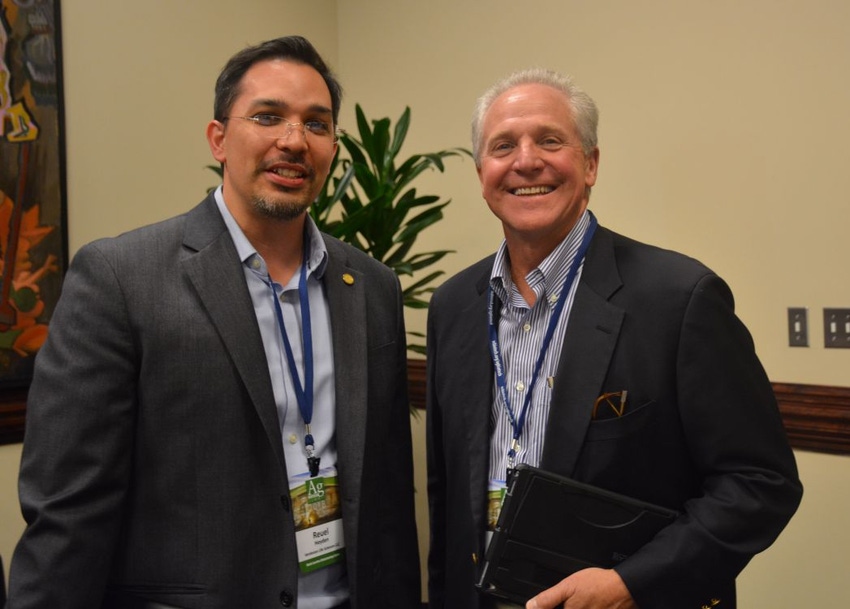
Russel Hedrick, a first-generation farmer in Catawba County, N.C., uses cover crops and no-till to boost his productivity and soil health. In 2016, Hedrick was the dryland division sate winner in the North Carolina Corn Yield Contest with a yield of 318.5 bushels per acre.
Hedrick focuses on nutrient management on his farm, turning to variable-rate fertility and zone sampling to save on his fertilizer bill. He uses zone sampling based on soil sol types then gives his crops prescriptions for fertility based on zones.
“The key thing we are focusing on is soil carbon, water extractable carbon and microbial active carbon. By doing that, we’ve started to hone in on our nitrogen management. Last year, we won the dryland division of the North Carolina state corn yield contest with a yield of 318 bushels with 140 units of nitrogen,” Hedrick said.
Hedrick still applied fertilizer, lime and chemicals on his 1,000 acres of row crops last year, but he saved $76,000 on his fertility bill in part by using the Haney Test, a practice he began four years ago. The Haney Test, or Soil Health Test, is an integrated approach to soil testing using chemical and biological soil data.
“It’s a love-hate relationship,” Hedrick said. “Some people love the Haney Test; some people hate it. It works on our farm, but it’s not a silver bullet,” Hedrick said.
Hedrick spoke about his practices at the Soil Health Summit sponsored by the North Carolina Biotechnology Center and Soil Health Institute at the University of North Carolina Friday Center in Chapel Hill. The purpose of the two-day summit was to find answers to improving soil health so that it will be productive year after year, generation after generation.
In the 20th century since the days of the Dust Bowl, soil quality was a focus of land management, but in the 21st century the terminology changed to soil health with the greater understanding that soil is living and should be managed accordingly.
Dr. Elizabeth Stulberg, science policy manager for the Alliance of Crop, Soil and Environmental Science Societies in Madison, Wisc., points out scientists have known since the 1890s when rhizobia was isolated that soil has a microbiological component. In the 20th century, she notes that soil management was primarily focused on the physical and chemical indicators of the soil. Today, the new focus is on microbes.
“With sequencing we can see a lot more of what’s going on. How to apply what we know, that’s the next big frontier. How do you alter a whole microbial community in the soil? How do you look at your neighbor’s field and say, ‘I want that?’ We might want to add microbes that aren’t present. We might want to help those communities of soil microbes through agronomic practices or prebiotics,” she said.
Stulberg was among the speakers at the Soil Health Summit.
Dr. Alan Franzleubbers, research ecologist with USDA’s Agricultural Research Service at North Carolina State University, put it into perspective when he noted there are more microbes in a teaspoon of soil then there are people on the planet.
“Healthy soil is biologically active,” he said.
Water infiltration is important, whereby water that lands on the soil is dirty but comes out clean. The functionality of soil for storage of carbon is also important. In fact, Franzluebbers points out that a key goal of grazing management is to improve soil health.
“Most people in the United States view rudiment livestock as detrimental to the environment, but by studying these animals on the landscape, we’ve been able to show that you actually store more carbon in soil and actually improve the function of soils rather than degrade them. Grazing is now viewed as a positive thing,��” Franzluebbers said.
Wayne Honeycutt, president and CEO of the Soil Health Institute in Morrisville, N.C., defines soil health as the “capacity of soil to function as a viable, living ecosystem that sustains plants, animals and humans. Soil health is a relationship between carbon and water and a relationship between not just yield but quality.”
No-till and cover crops have long been viewed as key to improving soil health. Storage of carbon and the ability to hold rainfall are also key.
In closing comments at the summit, Bill Buckner, president and CEO of the Noble Research Institute in Ardmore, Okla., emphasized the importance of expanding cover crop acreage across the country to improve soil health.
“Right now, we have 17 to 20 million acres of cover crop acreage. That’s small,” he said. “There is the potential of 350 million acres of arable cropland and 700-plus million acres of pasture and rangeland. That’s a 1-billion-acre potential.”
Buckner acknowledged that cover crop acreage will never come anywhere close to 1 billion acres in the United States, but he said incentives need to be given to farmers to turn to cover crops. He said a systems approach is needed so soil health can be monetized for farmers.
New cover crop cultivars need to be developed, and cover crops must be regionally adaptable. “We need to allow technologies to come through,” Buckner said. “We need gene editing in cover crops to solve a lot of those problems.
About the Author(s)
You May Also Like






